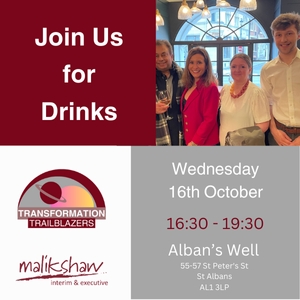Malikshaw Interim
Compliance within Public Sector Transformation Management

In the public sector, governance and compliance form the backbone of effective management. Whether driving organisational transformation or overseeing critical projects, strong governance ensures transparency, accountability, and alignment with the public interest. Compliance, on the other hand, safeguards the adherence to legal frameworks, policies, and ethical standards, which is crucial when public funds and resources are at stake.
Key Pillars for Transformation
Public sector organisations are increasingly undergoing transformations to adapt to new challenges, from digitalisation to responding to societal demands. A strong governance framework helps ensure that transformation initiatives remain on track, align with strategic goals, and are implemented transparently. For instance, local government digitisation projects, aimed at improving public service delivery, must be closely monitored to ensure they meet regulatory requirements, safeguard citizen data, and remain cost-effective.
Malikshaw’s work with local councils across the UK has demonstrated that successful transformation requires clear governance structures. For example, in a recent council restructuring, implementing a robust oversight committee to track progress, manage risks, and ensure compliance with budgetary constraints led to the successful rollout of the new operating model. Without these checks, cost overruns and project delays could have jeopardised the entire initiative.
Project Management and Compliance: Safeguarding Public Trust
When it comes to project management in the public sector, compliance becomes even more crucial. Large-scale projects, such as infrastructure developments or health service upgrades, often involve complex stakeholder networks, significant financial outlays, and strict timelines. Any misstep in compliance—whether financial, regulatory, or environmental—can lead to delays, public mistrust, or legal repercussions.
For example, the recent transformation of the NHS digital system required not only project management skills but also strict compliance with data privacy laws (GDPR) and healthcare regulations. Effective governance ensured these complex requirements were met while keeping the project on schedule.
Governance and compliance are not optional extras—they are essential for the successful management of transformation and projects within the public sector. By embedding strong governance frameworks and ensuring strict compliance, public sector organisations can drive meaningful change while maintaining public trust and accountability.
LORRAINE KIRBY
My Biography
I'm a sales and marketing professional with a long and varied career that has encompassed multiple retailing, not-for-profit marketing, logistics, international procurement and account management.
My Areas of Expertise
Category Management
Marketing
Social Media and Comms
My Languages
English
My Interests
Music
Politics
Crafting
I am a Recent graduate from De Montfort University with a 2:1 degree in Business and Management utilising my knowledge and skills to begin a career in recruitment. I pride myself in being a Driven individual who can effectively communicate with a wide range of people. This has given me experience with building relations with people, something I enjoy experiencing on a regular basis. I spend much of my free time playing football and challenging myself to learn new Sports.
PRIYANKA DUBEY
My Biography
I am an accomplished recruitment professional with over 15 years of experience in talent acquisition, client management, and full-cycle recruitment. Specialising in sourcing top talent, client relationship management, and ensuring compliance with employment legislation. I have a proven track record of delivering high-quality candidates across various industries and am currently pursuing CIPD Level 5 certification to further enhance my HR capabilities.
My Areas of Expertise
IT
Digital
HR
My Languages
English
Hindi
Urdu
My Interests
Travelling
Exploring new cultures
Cooking
I am a Recent graduate from De Montfort University with a 2:1 degree in Business and Management utilising my knowledge and skills to begin a career in recruitment. I pride myself in being a Driven individual who can effectively communicate with a wide range of people. This has given me experience with building relations with people, something I enjoy experiencing on a regular basis. I spend much of my free time playing football and challenging myself to learn new Sports.
Navigating Complex Public Sector Stakeholder Management

In the public sector, successful project execution hinges on one critical factor: stakeholder management. Unlike the private sector, where stakeholders might be more predictable and unified, public-sector projects must navigate a web of individuals, groups, and organisations—each with its own set of expectations and interests. From government agencies and regulatory bodies to local communities and advocacy groups, these stakeholders play a pivotal role in shaping project outcomes.
Public sector projects impact a wide spectrum of society. Whether it's a new infrastructure development, policy rollout, or a community initiative, each stakeholder has a vested interest in the project's success. However, this also introduces a challenge: how do you align these often-competing interests while maintaining transparency, accountability, and responsiveness?
In many cases, public sector projects face intense scrutiny—whether from the media, political figures, or the public itself. This scrutiny amplifies the need for effective stakeholder management, making it essential to keep communication open, transparent, and tailored to each stakeholder's needs. Furthermore, public sector projects often deal with strict regulations and compliance standards, requiring nuanced negotiations with regulatory bodies. Stakeholders need to feel heard and assured that their concerns are incorporated into the decision-making process.
The challenge here is not just in communication but in balancing competing priorities. For example, community groups may want swift action on an issue, while regulatory bodies might impose strict timelines or protocols that slow down the process. Navigating these tensions requires a deep understanding of public sector dynamics, conflict resolution skills, and the ability to foster consensus.
At Malikshaw Interim and Executive, we understand the intricacies of stakeholder management within the public sector. With years of experience, our consultants have successfully delivered tailored solutions to help public sector organisations manage their complex relationships. Malikshaw offers interim managers who possess the expertise required to address these challenges head-on.
Our interim executives have led some of the most challenging public sector projects, demonstrating a unique blend of strategic insight and hands-on expertise.
Successful stakeholder management in the public sector requires more than just communication; it requires strategic alignment with the interests of all parties involved.
Are you facing complex stakeholder dynamics in your public sector project? Contact Malikshaw Interim and Executive to find out how we can provide the right expertise to keep your projects on track and your stakeholders satisfied.
How Going Digital Made a Success of the Numbers

In the years leading up to 1800, the situation in the UK was dire. Harvests were failing, bread imports were blocked due to war with France, and Parliament was worried about whether there was enough food to feed everyone. But no one really knew how many people there were to feed. Estimates based on bread production, taxes, and church records were vague at best. There were fears that the population was growing faster than food production, which could lead to famine, but without reliable data, it was impossible to know for sure.
This uncertainty led to the Census Act, which became law on December 31, 1800, the day before the UK was officially formed. From then on, everyone in the country became a number.
Censuses weren’t new, though. The Babylonians had conducted one nearly 6,000 years ago. The Romans also used censuses to keep track of citizens and their property. In fact, the word “census” comes from the Latin word “censere,” which means “to estimate.” And, of course, the Domesday Book (1086).
For centuries, censuses around the world have been conducted on paper, requiring massive national efforts to manage, analyse, and share the data. Imagine the work involved in printing, distributing, collecting, and processing millions of paper documents. It’s no surprise that data analysis was a challenge. But technology has changed the game, and many countries have shifted from paper to digital systems. Some have found the transition easier than others.
The U.S. Census Bureau, for example, tried to lead the way with digital data collection in the year 2000, making the United States one of the first countries to use an internet-based method. However, by 2010, they had scrapped the idea due to concerns about response rates, costs, and security risks.
Fast forward to the UK's Census Transformation Programme (CTP), which recently pulled off one of the most successful transformations we've seen. Despite the challenges posed by the coronavirus pandemic, the first digital-first census in the UK achieved a 97% response rate, with 89% of households responding online. These numbers far exceeded the targets, proving just how effective the transformation was.
What made this success possible? It came down to strong leadership and a clear mission. With census day set for March 21, 2021, the leaders behind the transformation laid out a detailed plan to design a digital-first census that made sure everyone could take part. They learned from the U. S’s past challenges, addressing security concerns and ensuring that the digital systems could handle the peak loads.
Interestingly, even though this was an online census, paper still played a key role. The ONS provided paper questionnaires to those who needed them while encouraging online responses where possible. They tested their approach through the census test 2017 to understand what would work best for different segments of the population.
The level of detail that went into planning the online systems was incredible. Security was a top priority, as was ensuring the systems could handle huge volumes of activity and data, especially during the peak period on that day between 10:30am and 11:30am. Indeed, the story of our modern world will be told through data and some of the data sitting behind the census can be seen here if you are interested.: [ONS Census 2021 Digital Service]
But the real story is about the people who led this transformation to success. The leadership team’s choice to use agile delivery methods, continuous integration, and microservice architecture allowed for quick and effective changes. Decisions were carefully considered, tested, and refined.
Having joined the project in early 2017, we played a small part in this transformation and saw at first hand the journey that led to this brilliant result. In those early days, we provided expertise in programme planning, risk management and business analysis and progressed quickly to a series of high energy, proactive project managers, all with the skills and experience to deliver a multi-million pound project with many internal and external stakeholders.
Our involvement spanned through early design and development stages, working with architects, designers, developers, cloud ops, automation and cybersecurity experts at all levels up to and including deputy director. As you can imagine, there was a large focus not only on system design and development but layers and layers of data, so data architects, data engineers, data scientists all came in at different points.
Beyond the technical specialists, whole teams of people were brought in to manage the accuracy of data, so desk-based resolution teams were hired, as were many more operational people including census field support supervisors and agents, clerical matchers, HQ support staff, recruitment and campaign managers. To give you just a small picture, we alone provided over 150 specialist staff to the census and the co-running Covid Infection Survey. How many others were involved? I can't really say, but in 2021 it was recorded that the ONS employed 20,565 census field staff.
The point is that this was a huge programme and no less of a big transformation experiment. To deliver this as successfully as the ONS did, needed great leadership, a clear mission communicated effectively, teams of people who knew the part they each needed to play, deadlines that could not be missed and belief that they could deliver it on time. For a census that was about people, this was indeed all about the people. Leaders who knew how to lead, managers who knew how to manage and staff that were selected well to do the jobs they needed to do. Round pegs in round holes.
Further, there are at least two remarkable aspects to these simple observations – firstly, that the census went ahead as planned in the middle of a pandemic and secondly, that Scotland was missing.
The difficulty in pulling this transformation off successfully was reflected in the decision of Scotland (and others, including Republic of Ireland) to defer until 2022.
The ONS had belief and have been vindicated. Hats off to them.
Join Us For Drinks - Wednesday 16th October
Come meet the Malikshaw team at our regular catch-up event, this time at the Alban's Well, St Peters Street, St Albans 16:30 - 19:30. Get to know our experienced, Transformation specialists in person whether you're hiring now or planning for organisational change soon.
Cracking the Code: The Age of AI

AI is transforming industries, promising enhanced efficiency, smarter decision-making, and innovative solutions. However, integrating AI into an organisation’s operations isn’t without its hurdles. As organisations consider leveraging AI, they often face several challenges that require expert guidance and a strategic approach. This is where interim managers can play a crucial role.
1. Complex Implementation
Organisations may struggle with integrating AI solutions into their current infrastructure, particularly if they lack the necessary expertise in-house. Interim managers, with their specialised knowledge and experience, can guide organisations through the technical and strategic aspects of AI implementation, ensuring a smoother transition and minimising disruptions.
2. Data Management and Quality
AI systems rely heavily on data, and organisations often face challenges related to data collection, cleansing, and management. Interim managers can help establish robust data governance practices and ensure that the data used for AI is accurate, relevant, and secure.
3. Talent Shortages
There is a high demand for AI talent, but a limited supply of skilled professionals. Interim managers can bridge this gap by bringing in the necessary expertise on a temporary basis, allowing organisations to benefit from their experience without the long-term commitment of hiring full-time staff.
4. Ethical and Regulatory Considerations
The ethical implications and regulatory requirements surrounding AI are evolving rapidly. Interim managers with experience in AI governance and ethics can provide valuable insights and help organisations develop policies and practices that align with legal and ethical standards.
5. Change Management
AI adoption often requires significant changes to organisational processes and culture. Interim managers can play a key role in managing this transition, developing and executing change management strategies that address employee concerns and foster a culture of innovation and adaptability.
At Malikshaw Interim and Executive, we understand the intricacies of AI integration and are committed to providing organisations with the interim leadership needed to succeed in this evolving landscape. Our experienced interim managers are ready to help you tackle AI challenges and drive your organisation towards a successful digital future.
For more information on how we can support your AI initiatives, feel free to reach out to us.
Navigating Digital Transformation: A Strategic Advantage

Digital transformation is no longer just an option—it's a necessity. Organisations of all sizes face the challenge of integrating digital technologies to stay competitive, improve operational efficiency, and meet the growing expectations of customers. However, this transformation is not without its hurdles. From legacy systems and cultural resistance to the need for new skills and perspectives, the path to digital maturity can be complex and daunting.
This is where interim managers come into play as a vital resource for organisations navigating the digital challenge. Unlike permanent executives who may be entrenched in traditional ways of thinking, interim managers bring a fresh perspective and specialized expertise that can accelerate the transformation process. They are often seasoned professionals with a track record of leading digital initiatives, making them well-equipped to address both the strategic and operational aspects of digital transformation.
One of the key advantages of interim managers is their ability to hit the ground running. They are typically brought in for a specific purpose, such as overseeing the implementation of a new digital platform, restructuring a department to be more agile, or guiding the organisation through a digital culture shift. With no long-term commitment, interim managers are focused solely on delivering results. Their objective stance allows them to make tough decisions quickly, driving change without the constraints that often slow down permanent leadership.
Moreover, interim managers can act as catalysts for internal teams. They can help bridge the gap between traditional business practices and modern digital solutions, fostering a culture of innovation and continuous improvement. By mentoring existing leaders and transferring knowledge, they ensure that the organisation is not just reacting to digital trends but proactively shaping its digital future.
In conclusion, as organisations face the pressing need to digitally transform, interim managers offer a strategic advantage. Their ability to provide expert guidance, drive rapid change, and enhance internal capabilities makes them an invaluable asset in overcoming the digital challenges of today’s business environment. By leveraging interim talent, organisations can navigate the complexities of digital transformation with agility and confidence, positioning themselves for long-term success in the digital age.
JACK INGRAM
My Biography
I have recently graduated from the University of Warwick with a degree in History and Politics, Studying history has provided me with an excellent background in research and analysis, whilst my politics background has afforded me valuable communication skills with people from all walks of life. These skills have come in handy as I look to begin my career in recruitment. In my free time I still try and keep up with current affairs, read, and play football.
My Areas of Expertise
Research
Communication
Data Analysis
My Languages
English
My Interests
Reading
Football
Hiking
I am a Recent graduate from De Montfort University with a 2:1 degree in Business and Management utilising my knowledge and skills to begin a career in recruitment. I pride myself in being a Driven individual who can effectively communicate with a wide range of people. This has given me experience with building relations with people, something I enjoy experiencing on a regular basis. I spend much of my free time playing football and challenging myself to learn new Sports.
The Line Manager Challenge

Line managers are at the forefront of recruitment, retention, and contract extension—three critical pillars that directly impact an organisation's performance. Here's a look at how line managers can navigate these challenges while leveraging the unique advantages of interim professionals.
Recruitment: Finding the Right Fit Quickly
For line managers, recruitment is often a race against time. Vacancies need to be filled promptly to ensure that operations continue smoothly, yet finding the right talent is no easy feat. This challenge is even more pronounced when hiring interim managers, who are expected to deliver immediate results. The pressure to identify candidates with the right mix of expertise, industry knowledge, and cultural fit can be overwhelming.
To address this, line managers must streamline the recruitment process, focusing on clear, concise job descriptions and leveraging specialized recruitment agencies like Malikshaw Interim & Executive that understand the nuances of interim roles.
Retention: Keeping Talent Engaged
Retention is a well-known challenge in line management. Keeping permanent employees motivated and engaged is critical, but with interim managers, the dynamics are different. Interim professionals typically have shorter contracts and are often highly focused on specific objectives. However, their engagement is crucial, as their performance can significantly impact the success of a project or initiative.
To retain interim managers, line managers must create an environment where they feel valued and empowered. Regular check-ins, clear communication of expectations, and recognition of their contributions can go a long way. It’s also important to integrate them into the team culture, making them feel like part of the organisation, even if their stay is temporary.
Contract Extension: Balancing Needs and Expectations
Extending contracts for interim managers presents its own set of challenges. While an interim manager may have successfully led a project, extending their contract requires careful consideration. Line managers must weigh the benefits of continuity against the potential for over-reliance on interim solutions.
When considering an extension, line managers should evaluate the interim manager's performance, the ongoing needs of the project, and the availability of internal talent to take over. Open dialogue with the interim manager about their interest in continuing and the conditions under which they would stay is essential. Balancing the organisation’s needs with the interim manager’s expectations is key to making informed decisions that benefit both parties.
Conclusion: Strategic Line Management
By adopting a strategic approach—focusing on clear recruitment processes, fostering engagement, and making informed extension decisions—line managers can effectively manage these challenges. Interim managers, when well-integrated and properly supported, can provide invaluable expertise and agility, helping organisations navigate periods of change and drive success in critical projects.
















